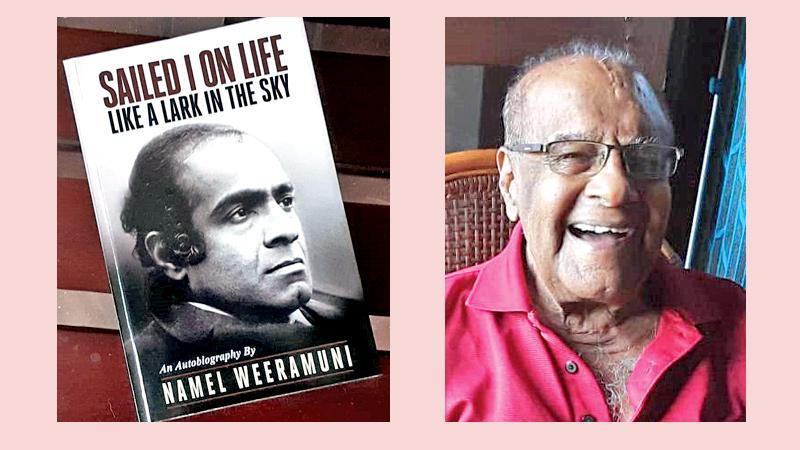
An artist whose areas of activity include acting, directing and playwriting, Namel Weeramuni is a versatile personality who has also over the years shown his skills as a translator of Western plays to Sinhala as well as a translator of Sinhala literary works to English.
A legal practitioner who had a lucrative practice as a Solicitor in England, Weeramuni also holds a BA from the University of Ceylon where he had his initiation to the hallowed space of theatre under the tutelage of his guru, the much-revered late Prof. Ediriweera Sarachchandra.
The journey of this multifaceted personality is recalled in his autobiography titled ‘Sailed I on Life Like a Lark in the Sky’.
This book recounts in Weeramuni’s own words of his trials, travels and triumphs through narratives that bring out his consciousness reflecting on his life as a lad from a village who steadily gained ground in new arenas of skills and experiences as his steps sought to systematically raise him to new heights and allowed him to set sail upon the boundless skies. It is indeed the story of a traveler through the great journey of life.
Vignettes
Weeramuni has structured his narrative in the form of 99 Chapters, most of which act as almost an intricately bound series of vignettes that takes the reader on a chronological path of the author’s life touching on significant events and people that have shaped his journey across villages, towns, cities, provinces, countries and cultures. The opening speaks about the author’s modest childhood roots in Ahungalla in the South of Sri Lanka, and at the very outset the reader is met by the authorial voice devising a narrative that builds an account of what he believed to hold true about his stage of infancy, marking a poignant revelation where Weeramuni speaks of the elder sister he never knew. The sister who bade farewell to life at a tender age, of whom the author cannot factually claim a personal memory. Thus the ‘scenes’ move with life and vigour bound to a myriad of emotions woven with events, incidents and characters that create moments of dramatic merit as the reader is addressed by a conscious authorial voice that sees the joys of recollection as a life lived once more.
Development as an artist
One of the more important facets that can be extracted from the autobiographical narrative is the description of events and persons who shaped Namel Weeramuni the artiste. For it is for this facet of his life that the author is best known and much loved among the Sri Lankan public. In this regard I would like to cite the following chapters of the book as noteworthy to those who wish to learn about the roots of Weeramuni’s development as an artist. Chapters, 14, 15, 27, 30, 31, 32, 37, 39, 40, 41, 58, and 79 are significant for the glimpses they offer into the author’s engagement in theatre, from his first impressions of witnessing theatrical performances as a child (described in chapters 14 and 15) which includes a folk ritual performance as well as a local show, to his gradual involvement in theatre as an artist and an activist of the arts.
What is notably significant in these sections of the book is that there are kernels of Sri Lankan theatre history which will be useful to theatre students when looking at the aspect of Sri Lanka’s theatre history. Thus there is an element that offers research value to scholars who may want sources of references, for example, details related to Prof. Sarachchandra’s formation of his theatre troupe at Peradeniya campus, where ‘the legend of Maname’ finds its beginnings.
When looking closely and critically at the substance that forms the narrative of his autobiography, I must say that in my personal opinion, Weeramuni could have focused more on, and expanded, the parts related to his theatre life and thus incorporated deep contemplation on his outlooks on theatre, since he is known among the Sri Lankan public today as Sri Lanka’s most senior theatre practitioner. Regardless of that point, the manner in which it has been written, in the tone and flow of a convivial narrator, projecting capturing facets of a bygone era which was tranquil and colourful in many ways, I believe Namel Weeramuni’s autobiography ‘Sailed I on Life Like a Lark in the Sky’ will please readers.
